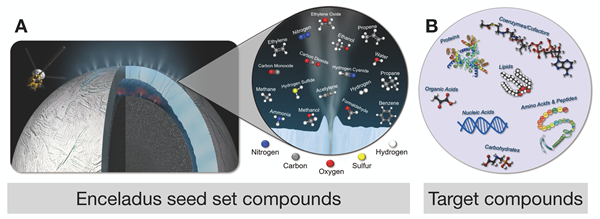To better predict whether Earth-life, such as microorganisms, are viable on other planets, scientists need more computational predictive tools. In a recent paper, Smith et al. lay out a framework for combining existing tools to make predictions about life’s abilities to generate necessary chemicals in different planetary environments. They demonstrate this framework using a subset of prokaryotes with data collected on Saturn’s moon Enceladus. While they found these organisms to be inviable, the research provides an essential foundation for more quantitatively predictive astrobiology and can be applied flexibly across organisms and planetary environments.

Is life reliant on Earth’s unique biogeochemical environment? Or might organisms from our planet be able to sustain themselves in unfamiliar worlds? The answer to these questions has far reaching scientific implications – from understanding the interplay of geology and biology at the origin of life to determining whether it’s feasible to terraform other planets like Mars. However, making progress on these questions is difficult because it’s not easy to do experiments on other planets. Often scientists try to recreate those conditions and grow organisms in the lab to better understand the effects that other planetary environments have on Earth-life. Otherwise, scientists also tend to visit areas on Earth those bear similarities to other planets and make observations.
Both of these approaches yield valuable insights but carry a high cost in time and money. It is expensive to travel and conduct fieldwork, and it’s slow to prepare and monitor organismal growth. Instead, what if there was an alternative way to make predictions about the viability of Earth-life on other planets based on the kind of data that biologists routinely collect and upload to large databases, and the kind of data already being collected on planetary missions? A new paper by Earth-Life Science Institute (ELSI) at Tokyo Institute of Technology research scientist Harrison Smith, alongside colleagues at Arizona State University, lays out a framework for unifying these types of data to make predictions about the viability of Earth-life on other planets. They demonstrate this framework by computationally investigating the viability of organisms on Enceladus.
In their paper, they use data catalogued by the Joint Genome Institute (JGI) to identify a subset of organisms known to live on Earth in the same pH range that is found in Enceladus’s ocean. They then identify the catalytic capabilities of these organisms via JGI data. By combining this information with chemicals identified from various Enceladus observations, they were able to identify all the reactions that each organism could catalyze, based on the chemicals identified as available from Enceladus. Using a network-expansion process, they ran a simulation that iteratively identified these catalyzable reactions, and chemical products of those reactions. The process repeats until no new chemicals can be produced based on the available chemicals and the catalytic capabilities of the organism. Those chemicals produced can then be compared to a list of chemicals that are broadly needed for organismal survival across the tree of life. If the organism cannot make all of the chemicals in the list, it is considered inviable.
By applying this technique across all of the earlier identified organisms, they are able to ask—does this subset of Earth-life appear to be viable with what is known about Enceladus’s environment? Unfortunately, these organisms do not appear to be viable. However, perhaps this was simply because one of the key elements of life, phosphorous, has not been detected on Enceladus, and thus was not included as an available chemical for life to use. Phosphorous is hard to detect, especially at low levels, so it’s not unreasonable to assume that it is present in at least some amount. When the researchers included phosphorous, they find that while organisms can produce more chemicals than they could before, it still falls short of what’s needed for viability.
The researchers then investigated what kinds of compounds would be required for detection on Enceladus in order for these organisms to gain viability, using a variant on the network-expansion technique. They found that at minimum, several more compounds would be required, and that these compounds would need to be bigger and more complex than what we currently know to exist on Enceladus.
But not all hope is lost—the compounds which have currently been observed on Enceladus are limited by instrument sensitivity, which can improve with future missions. And the framework identified here can be applied to any planetary environments and organismal reaction networks, meaning that as data collection improves, better predictions can be made—leading to insights on the interdependency of life and the planet it originates from.
| Journal | Astrobiology |
| Tile of the paper | Seeding Biochemistry on Other Worlds: Enceladus as a Case Study |
| Authors | Harrison B. Smith1,*, Alexa Drew1, John F. Malloy1, and Sara Imari Walker1–4 |
| Affiliations | 1. School of Earth and Space Exploration, Arizona State University, Tempe, Arizona, USA. 2. ASU-SFI Center for Biosocial Complex Systems, Arizona State University, Tempe, Arizona, USA. 3. Beyond Center for Fundamental Concepts in Science, Arizona State University, Tempe, Arizona, USA. 4. Santa Fe Institute, Santa Fe, New Mexico, USA. *Current affiliation: Earth-Life Science Institute, Tokyo Institute of Technology, Tokyo, Japan |
| DOI | 10.1089/ast.2019.2197 |
| Online published date | 4 February, 2021 |
